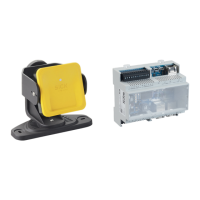Safety Page: 13 Personnel Skills Outlines required skills for machinery manufacturers, installers, and technicians.
Safety Assessment Requirement for safety assessment as per Machinery Directive before device use.
Intended Use Details safeRS3 certifications, functions, and applications.
General Warnings Important warnings about installation, configuration, and system limits.
Responsibility Defines responsibilities of the machinery manufacturer and system installer.
Limits System limitations in detecting immobile or non-breathing people.
Disposal Guidance on safe disposal of the product according to regulations.
Conformity Information on standards, directives, and CE conformity.
CE Manufacturer's statement of conformity with EU directives.
Get to Know safeRS3 Page: 18 safeRS3 General introduction to the safeRS3 system.
Definition Defines safeRS3 as an active protection radar system for monitoring dangerous areas.
Special Features Highlights key features like distance/angle detection and protective fields.
Applications How safeRS3 integrates with machinery control systems for safety.
Functions Lists the core functions performed by the safeRS3 control unit.
Structures Details the physical structure and components of the control units.
Inputs Describes the system's digital inputs and their programming functions.
SNS Input Details the SNS input for checking input status and diagnostic function.
Outputs Describes the four digital OSSD outputs and their functions.
Functions Lists the primary functions performed by the safeRS3 sensor.
2-Axes Structure Details the mechanical structure of the sensor with 2-axis rotation.
3-Axes Structure Details the mechanical structure of the sensor with 3-axis rotation.
Status LED Explains the different states indicated by the sensor's status LED.
Functions Lists the main functions of the safeRS3 Designer application.
Access Explains password protection and access levels for application functions.
Main Menu Overview of the main menu structure and functions within the application.
Modbus Support Details Modbus communication availability and requirements.
Functioning Principles Page: 36 Introduction Introduces the FMCW radar technology used by the safeRS3 sensor.
Introduction Introduces protective fields and their dedicated detection signals.
Angular Coverage Defines the range and requirements for angular coverage of protective fields.
Introduction Introduces the safety working modes and functions.
Safety Working Modes Details the "Both", "Always access detection", and "Always restart prevention" modes.
Introduction Introduction to the static object detection option.
Availability Information on firmware requirements for static object detection.
Operation How the static object detection option operates.
Muting Explanation of the muting function and its configuration.
Description Defines muting as a temporary suspension of safety functions.
When to Disable Situations where disabling the anti-rotation function might be necessary.
Settings Configuration options for anti-masking distance and sensitivity.
When to Disable Conditions under which the anti-masking function should be disabled.

